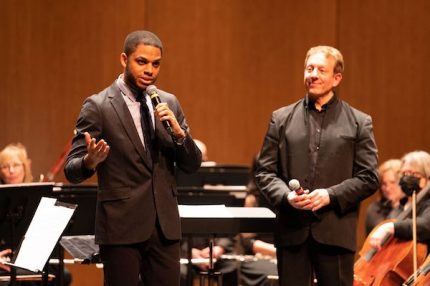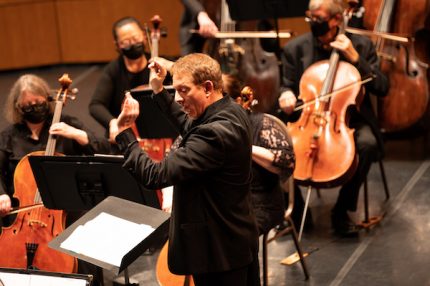Chicago Philharmonic tucks an appealing premiere between Brahms and Dvořák Serenades

A lighter, swifter Ferrari to the stolid Rolls Royce of its mighty crosstown rival, the Chicago Philharmonic has the scheduling flexibility the Chicago Symphony Orchestra simply lacks, even in times not beset by a pandemic. Take the Philharmonic’s enterprising composer-in-residence program, for example.
The orchestra, which performed a relatively lightweight if satisfying classical program Sunday afternoon at the North Shore Center for the Performing Arts in Skokie, will be devoting a key portion of its programming in coming seasons to new works by a triumvirate of young resident composers, beginning this year and ending in 2023-24.
For its part, the CSO will be showcasing only one in-house composer, the gifted Jessie Montgomery, in various capacities, also for three seasons.
Granted, Covid-era protocols have further complicated the already complex artistic planning at the CSO; so the orchestra has been unable to slot any big Montgomery premieres thus far. Even so, those limitations have not deterred the Philharmonic from presenting two such premieres from its resident musicians already this season.
The latest of these, Jonathan Bingham’s Tautology, received its world premiere as the centerpiece of Sunday’s concert under the baton of artistic director and principal conductor Scott Speck. The commission work was sandwiched between two Romantic serenades: Brahms’ Serenade No. 2 and Dvořák’s Serenade for Wind Instruments.
It was by no means coincidental that Bingham, who hails from the San Francisco Bay area and is based in New York City, scored his nine-minute opus for the same instrumentation Brahms employs in his A-Major Serenade—pairs of wind instruments plus violas, cellos and basses in lieu of a full string section: thus the prominence given to the dusky coloration of lower strings in the Bingham.
The dictionary defines tautology as the saying of the same thing in different words, usually in close succession. Bingham takes the concept in a musical direction based on the time-honored form of passacaglia—a ground bass repeated over and over as a structural foundation for melodic development on top.
Structure is the key generative element in Tautology, in which two contrasting sections are created out of bass ostinatos that are paradoxically different but essentially the same—identical forms, disparate material.
If all this makes the piece sound rather forbiddingly academic, it isn’t. Bingham is a young American composer worth watching. He writes accessibly and well for smaller orchestral forces, with a keen ear for instrumental color. His rippling, long-breathed tonal lines, gently unfolding over open textures, build from serene beginnings in solo instrumental lines (fineuse of clarinet and viola) to lyrically intense climaxes. There is a kind of post-minimal repetition going on here, but it is not at all rhythmically driven, nor does it seek modernist harmonic vistas—it is, in short, its own unpretentious creation, its neo-baroque contours lovely and beautiful to behold.

The graceful serenity inherent in the Bingham opus found congenial company in the jovial, outdoorsy exuberance of the two serenades. Although the Dvořák and Brahms are well represented on disc, they turn up in the concert hall less often, no doubt because of their unusual instrumentation. (The Dvořák calls for winds, horns, and low strings, with optional contrabassoon, a welcome fillip in Sunday’s performance.)
Speck paced the Dvořák Serenade moderately but flexibly, bringing out the wealth of folk-flavored melody and distinctive wind-string coloration. The Presto trio of the Menuetto movement danced charmingly, and one had to single out the pairs of oboes and clarinets for their lively contributions. That said, it’s too bad that the first horn suffered a losing battle with embouchure and intonation, most noticeably in the fanfares that conclude the finale.
The Opus 16 Serenade, the delightful result of the young Brahms’ attempt to write a symphony that really wouldn’t be judged as a symphony, came off comparably well. It wasgood to hear the CPO’s fine viola choir liberated (so to speak) and in such fine fettle—nice too, to behold phrases rising and falling with enough rubato to insure warm lyrical impetus. The sound was well-balanced and well-tuned, although one would have welcomed some portamento in the string playing.
There were friendly elbow-bumps between conductor and players throughout the concert, as befit the overall musical mood of relaxed pleasures.
The Chicago Philharmonic season continues March 27 at the Harris Theater for Music and Dance, with a program of Respighi, Jennifer Higdon and world premieres by Nicholas Hubbell and composer-in-residence Reinaldo Moya. chicagophilharmonic.org.
Posted in Performances

